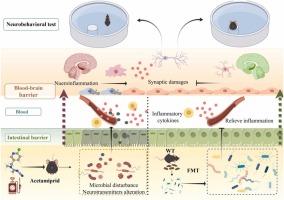啶虫脒通过肠-脑轴介导认知功能障碍:突触损伤和免疫介导的血脑屏障功能障碍
IF 11.3
1区 环境科学与生态学
Q1 ENGINEERING, ENVIRONMENTAL
引用次数: 0
摘要
扑热息痛是一种广泛使用的新烟碱类杀虫剂,可增加诱发神经系统疾病的风险。考虑到对乙酰氨脒暴露量的增加及其对认知功能的影响,需要进一步澄清。因此,我们使用饮水小鼠模型来评估对乙酰米虫脒对认知功能障碍的影响及其可能的潜在机制。我们的研究表明,乙酰氨脒会对小鼠海马和突触结构造成损伤,从而导致小鼠空间学习和记忆能力下降。重要的是,乙酰脒暴露改变了肠道菌群的组成和多样性,并诱导了肠脑轴的系统性免疫反应。具体来说,乙酰脒暴露会损害肠脑轴,包括肠道菌群、相关神经递质和全身免疫因子的结构性紊乱。此外,粪便微生物群移植恢复了肠道微生物群的稳态,降低了突触和空间学习记忆的损伤程度。此外,肠道屏障功能得到恢复,有效防止有害物质进入肠道组织,从而减少对血脑屏障的损伤和肠脑的免疫反应。本研究为对乙酰氨基胺暴露与认知功能相关的潜在新机制提供了新的见解。本文章由计算机程序翻译,如有差异,请以英文原文为准。

Acetamiprid mediates cognitive dysfunction through the gut-brain axis: synaptic damage and immune-mediated blood-brain barrier dysfunction
Acetamiprid is a widely used neonicotinoid pesticide that can increase the risk of inducing nervous system diseases. Considering the increased exposure to acetamiprid and its impact on cognitive function, further clarification is needed. Therefore, we used a mouse model of drinking water to evaluate the effects of acetamiprid on cognitive dysfunction and the possible underlying mechanisms. Our study revealed that acetamiprid can cause damage to hippocampal and synaptic structures, which in turn leads to a decline in spatial learning and memory abilities in mice. Importantly, acetamiprid exposure altered the composition and diversity of the intestinal flora and induced a systemic immune response in the gut brain axis. Specifically, acetamiprid exposure damages the gut
brain axis. Specifically, acetamiprid exposure damages the gut brain axis, including structural disorders of the intestinal flora, related neurotransmitters and systemic immune factors. In addition, fecal microbiota transplantation restored the homeostasis of the gut microbiota and reduced the degree of damage to synaptic and spatial learning and memory. Moreover, intestinal barrier function is restored, effectively preventing the entry of harmful substances into intestinal tissue and thereby reducing damage to the blood
brain axis, including structural disorders of the intestinal flora, related neurotransmitters and systemic immune factors. In addition, fecal microbiota transplantation restored the homeostasis of the gut microbiota and reduced the degree of damage to synaptic and spatial learning and memory. Moreover, intestinal barrier function is restored, effectively preventing the entry of harmful substances into intestinal tissue and thereby reducing damage to the blood brain barrier and the immune response in the gut
brain barrier and the immune response in the gut brain. This study provides new insights into potential new mechanisms of acetamidine exposure related to cognitive function.
brain. This study provides new insights into potential new mechanisms of acetamidine exposure related to cognitive function.
 brain axis. Specifically, acetamiprid exposure damages the gut
brain axis. Specifically, acetamiprid exposure damages the gut brain axis, including structural disorders of the intestinal flora, related neurotransmitters and systemic immune factors. In addition, fecal microbiota transplantation restored the homeostasis of the gut microbiota and reduced the degree of damage to synaptic and spatial learning and memory. Moreover, intestinal barrier function is restored, effectively preventing the entry of harmful substances into intestinal tissue and thereby reducing damage to the blood
brain axis, including structural disorders of the intestinal flora, related neurotransmitters and systemic immune factors. In addition, fecal microbiota transplantation restored the homeostasis of the gut microbiota and reduced the degree of damage to synaptic and spatial learning and memory. Moreover, intestinal barrier function is restored, effectively preventing the entry of harmful substances into intestinal tissue and thereby reducing damage to the blood brain barrier and the immune response in the gut
brain barrier and the immune response in the gut brain. This study provides new insights into potential new mechanisms of acetamidine exposure related to cognitive function.
brain. This study provides new insights into potential new mechanisms of acetamidine exposure related to cognitive function.
求助全文
通过发布文献求助,成功后即可免费获取论文全文。
去求助
来源期刊

Journal of Hazardous Materials
工程技术-工程:环境
CiteScore
25.40
自引率
5.90%
发文量
3059
审稿时长
58 days
期刊介绍:
The Journal of Hazardous Materials serves as a global platform for promoting cutting-edge research in the field of Environmental Science and Engineering. Our publication features a wide range of articles, including full-length research papers, review articles, and perspectives, with the aim of enhancing our understanding of the dangers and risks associated with various materials concerning public health and the environment. It is important to note that the term "environmental contaminants" refers specifically to substances that pose hazardous effects through contamination, while excluding those that do not have such impacts on the environment or human health. Moreover, we emphasize the distinction between wastes and hazardous materials in order to provide further clarity on the scope of the journal. We have a keen interest in exploring specific compounds and microbial agents that have adverse effects on the environment.
 求助内容:
求助内容: 应助结果提醒方式:
应助结果提醒方式:


